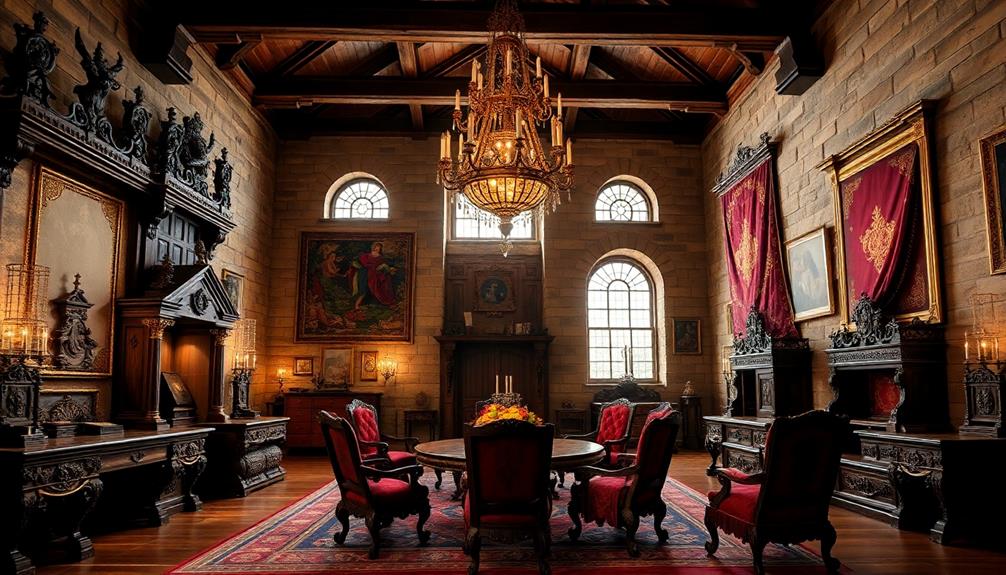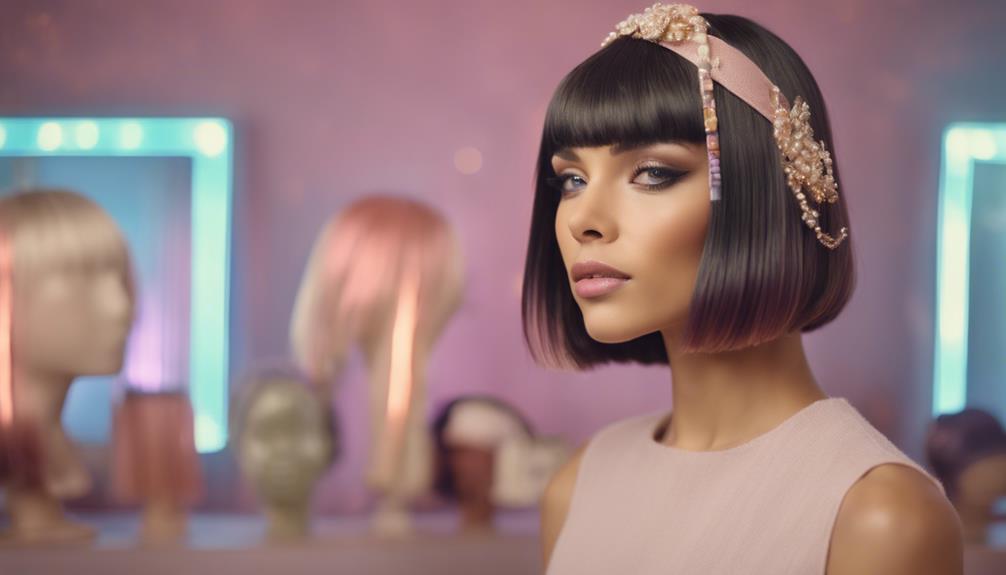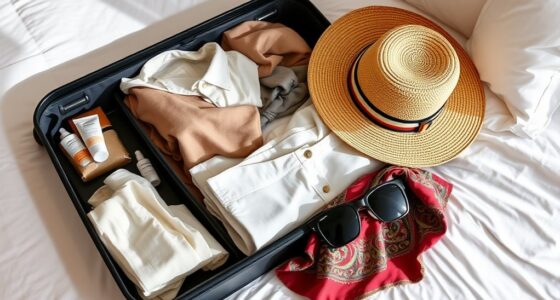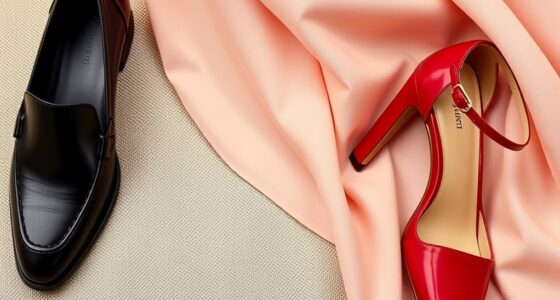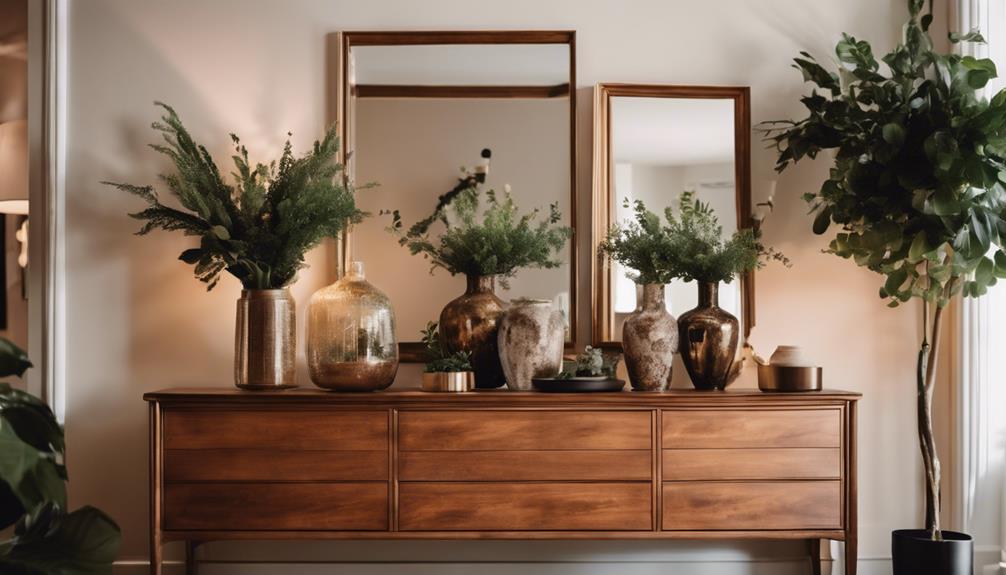The Spanish dress, especially the flamenco attire, embodies a stunning silhouette that reflects a rich cultural heritage. You'll notice the ruffled necklines and vibrant polka dot fabrics that enhance elegance and movement. The dress's layers create captivating twirls, perfect for expressing the passionate spirit of Spain. Today, modern designers blend these traditional elements with contemporary styles, keeping this cultural identity alive. Personalization options further allow you to showcase your unique style. If you're curious about the evolution of these designs or how to incorporate them into your wardrobe, you'll uncover even more fascinating insights ahead.
Key Takeaways
- The flamenco dress, or traje de flamenca, is characterized by vibrant colors, ruffles, and signature ruffled necklines, symbolizing Spanish cultural identity.
- Traditional Spanish dress blends influences from Gypsy, Moorish, and Jewish cultures, reflecting a rich historical tapestry in its design.
- Signature elements like volantes (ruffled skirts) and lunares (polka dots) enhance the visual appeal and movement, vital for flamenco dance performances.
- Modern Spanish fashion incorporates sustainable practices while honoring traditional craftsmanship, showcasing the evolution of iconic silhouettes in contemporary designs.
- Fashion icons and events like Madrid Fashion Week highlight the cultural significance of Spanish dress, merging heritage with modern aesthetics and activism.
Origin and historical background of the fashion trend/style
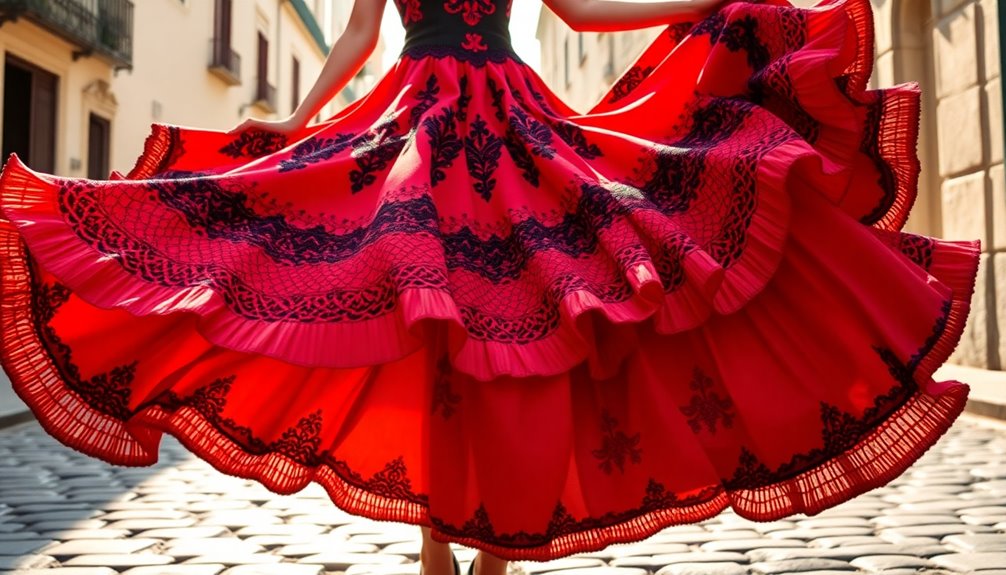
When you look at the evolution of Spanish dress, you'll notice how it transformed through the influences of royalty and nobility.
Each era brought unique elements that shaped the silhouette, merging elegance with cultural significance.
This historical journey not only reflects the changing tastes of the elite but also highlights the rich tapestry of Spain's fashion heritage.
Historical Transformation of Fashion
The historical transformation of Spanish dress reflects a rich tapestry of cultural influences and societal shifts. You’ll notice that the origins of this attire are deeply rooted in the diverse cultures of the Gypsies, Moors, and Jews in southern Spain. This blend shaped traditional clothing and customs, revealing a vibrant cultural narrative. Today, modern Spanish dress continues to evolve, influenced by global fashion trends and the changing roles of women in society. While traditional elements such as the mantilla and flamenco dress still hold significance, there is also a growing fusion of traditional and contemporary styles. This blend reflects the dynamic nature of Spanish culture, as well as the country’s openness to embracing new ideas and influences.
Among the most iconic garments is the traje de flamenca, which has evolved over centuries. Characterized by its striking colors and ruffles, it merges historical styles with modern trends, symbolizing cultural identity.
Interestingly, the term "Flamenco" is thought to derive from the Arabic "Felah-Mengus," meaning wandering peasant, illustrating the connection between dress and the region's nomadic history. Throughout the 19th and 20th centuries, traditional Spanish fashion underwent significant transformations. Societal changes and globalization introduced contemporary elements, allowing classic garments to adapt and thrive.
Festivals like Feria de Abril and Feria de Málaga showcase this evolution, emphasizing the cultural significance of traditional attire, especially the flamenco dress. These events not only celebrate heritage but also highlight how fashion can evolve while maintaining its roots within a dynamic cultural landscape. Additionally, the emotional alignment of individuals during these cultural celebrations often enhances the vibrational energy surrounding the attire and performances.
Spanish Royalty and Nobility
Historically, Spanish royalty and nobility have played a pivotal role in shaping fashion trends that reflect their status and wealth. These influential figures often showcased traditional Spanish garments adorned with intricate embroidery and luxurious fabrics. The ceremonial traje de gala, for instance, was a staple during state occasions, characterized by its opulence and meticulous attention to detail.
In the 18th century, Spanish court fashion gained international acclaim for its flamboyant styles, featuring wide skirts and lavish decorations that mirrored the Baroque aesthetic. This era not only emphasized grandeur but also set a standard for elegance.
Among noblewomen, the mantilla—a lace or silk veil—emerged as a quintessential symbol of sophistication. Worn during religious ceremonies and formal events, its roots trace back through centuries of cultural tradition, further highlighting the rich history of Spanish fashion.
Even today, the influence of Spanish nobility endures as contemporary designers draw inspiration from these historical garments, creating collections that honor this heritage.
Key Characteristics
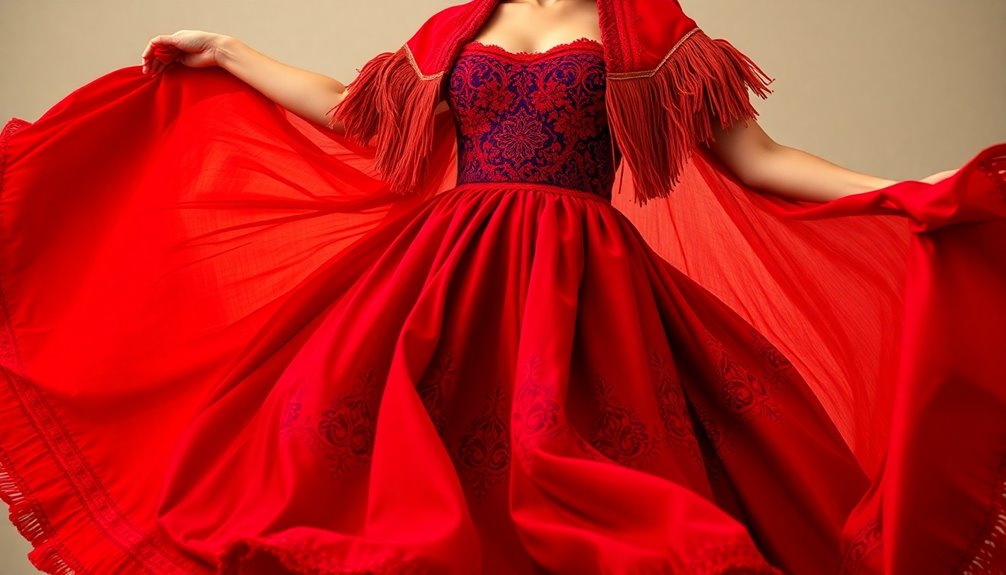
When you think of the traditional Spanish dress, the signature ruffled necklines and skirts immediately stand out.
You can't miss the vibrant polka dot fabrics that add a playful touch, embodying the lively essence of flamenco culture.
These key characteristics not only enhance the visual appeal but also bring the dress to life during dance performances.
Signature Ruffled Necklines
Elegance and movement intertwine in the signature ruffled necklines that define traditional Spanish dresses, especially flamenco attire. These necklines are a hallmark of the style, enhancing the beauty and dynamism of every dance performance.
You'll notice that they often feature multiple layers of ruffles, known as volantes, which vary in size and fullness, adding dramatic flair to the garment.
Designed to frame your face, ruffled necklines highlight your expressions, making them integral to the visual impact while dancing. The choice of fabric, like silk or lace, emphasizes the texture and richness, aligning perfectly with Spain's cultural significance in fashion.
Ruffled necklines aren't just functional; they serve as a canvas for artistic expression, allowing for personal interpretation and creativity in flamenco fashion. Each ruffle can reflect your unique style, making traditional dresses feel fresh and individualized.
Vibrant Polka Dot Fabrics
Vibrant polka dot fabrics, often seen in traditional Flamenco dresses, consistently bring a sense of energy and passion to the dance. These polka dots, or lunares, come in bold colors that capture the lively spirit of Spanish culture. The lightweight materials used for these fabrics allow for fluid movement, enabling dancers to showcase dramatic flair with every twirl.
You'll notice that the size and arrangement of the polka dots can vary significantly. Larger dots make a bold statement, drawing attention, while smaller dots offer a more delicate touch, adding an elegant charm. This versatility enhances the visual appeal of traditional Flamenco attire, making each dress unique and captivating.
The historical evolution of polka dots in Flamenco fashion showcases a blend of modern interpretations and traditional designs. Even as styles change, the essence of these fabrics remains rooted in the festive spirit of Spain. Additionally, the vibrant colors and patterns often reflect regional variations found in local cultural practices, further enriching the visual storytelling of the dance.
Signature Ruffled Skirts
Ruffled skirts, known as "volantes," are a defining feature of traditional Flamenco attire, complementing the lively polka dot fabrics perfectly. These voluminous skirts are typically fitted at the waist and flare out dramatically, allowing you to create captivating twirls that enhance your visual appeal during dance. As you move, the ruffles add a dynamic flair, making every performance unforgettable.
Flamenco dresses often showcase vibrant colors and bold patterns, with polka dots (lunares) being especially popular. This reflects the lively spirit of Flamenco culture and provides an opportunity for you to express your personality through your choice of attire. The arrangement and number of ruffles can vary widely, giving you the freedom to be creative and showcase your individuality.
To elevate the elegance of your ensemble, consider pairing your ruffled skirt with additional layers such as a mantón (shawl) or a peineta (decorative comb). These accents not only enhance the overall look but also contribute to the rich tradition of Flamenco fashion.
With a signature ruffled skirt, you embody the essence of Flamenco, celebrating both its history and vibrant energy.
Modern Interpretation
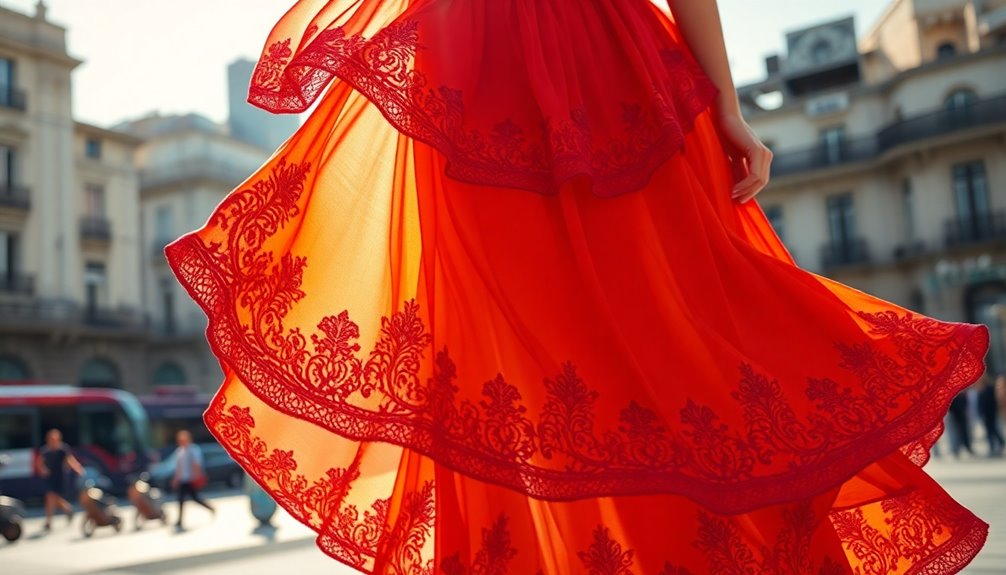
When you look at modern Spanish dress, you'll notice a shift towards sustainable fabric choices that reflect a growing awareness of ethical production.
Leading Spanish fashion labels are pushing boundaries, creating innovative designs that blend tradition with contemporary aesthetics.
Fashion icons of Spain are embracing this movement, showcasing how heritage can harmonize with modern values in striking ways.
Sustainable Fabric Choices Emerging
As sustainable fashion gains traction in Spain, designers are turning to eco-friendly materials like organic cotton, recycled polyester, and Tencel to breathe new life into traditional garments.
These sustainable fabric choices reflect a growing commitment to environmental responsibility while honoring Spanish culture. By merging age-old techniques with modern innovations, they create pieces that resonate with both heritage and contemporary values.
The rise of brands dedicated to transparency and ethical production practices showcases a significant shift in the Spanish fashion industry.
Events like Madrid Fashion Week spotlight collections that emphasize sustainability, proving that eco-conscious designs can be both stylish and culturally relevant.
Artisans are also playing a vital role by incorporating sustainable practices into their craft, utilizing locally sourced materials and low-impact dyeing techniques.
Consumer interest in sustainable fashion continues to grow, with a notable percentage willing to pay more for brands that prioritize eco-friendly practices.
This demand is reshaping the landscape of Spanish fashion, encouraging designers to explore sustainable fabric choices that pay homage to their roots while addressing modern environmental concerns.
As you embrace these trends, you're not just wearing a garment; you're supporting a sustainable future for fashion.
Leading Spanish Fashion Labels
Spanish fashion labels are redefining style by merging traditional craftsmanship with modern aesthetics. Brands like Cristóbal Balenciaga and Loewe expertly blend cultural heritage with contemporary design, showcasing unique silhouettes that tell a story. Their creations often pay homage to the traje, the traditional attire, while infusing it with fresh, innovative elements.
Mango and Zara have taken the global fashion scene by storm, offering affordable yet stylish options that make Spanish fashion accessible to everyone.
Desigual stands out with its vibrant patterns and eclectic designs, often incorporating aspects of Spanish culture into its collections. This playful approach to fashion invites you to express your individuality.
As sustainability becomes increasingly important, many Spanish labels are also embracing eco-friendly practices. Ecoalf, for instance, leads the charge in using sustainable materials and ethical production methods.
The rise of local designers like Palomo Spain further emphasizes a modern interpretation of traditional Spanish attire, marrying classic elements with contemporary flair.
In this dynamic landscape, Spanish fashion labels continue to inspire and innovate, ensuring that the iconic silhouette remains relevant and celebrated worldwide.
Fashion Icons of Spain
While traditional Spanish fashion has deep roots, modern icons are reshaping its narrative with fresh interpretations. Designers like Pedro del Hierro and Manolo Blahnik are merging classic Spanish elements with contemporary design, creating pieces that resonate globally.
You'll find that Flamenco dresses feature prominently in their collections, showcasing a blend of traditional craftsmanship and modern flair.
Rosalía, a modern cultural icon, has played a significant role in popularizing traditional Spanish attire, effortlessly weaving it into her music and performances. Her influence brings a new energy to these styles, making them relevant to today's audience.
Additionally, brands like Balenciaga, under Matthieu Blazy's direction, present LA-inspired designs that reflect a modern interpretation of Spanish aesthetics. This shift is further enhanced by the rise of sustainable fashion, where Spanish designers focus on eco-friendly materials, marrying ethics with cultural heritage.
Spanish streetwear brands are also making waves, integrating cultural motifs and traditional elements into collections that appeal to a younger, global audience. This evolution in design reflects the importance of sharing parenting responsibilities as it encourages collaborative creativity among designers.
These modern interpretations not only celebrate Spain's rich fashion history but also ensure its relevance in today's ever-evolving landscape.
Styling Tips
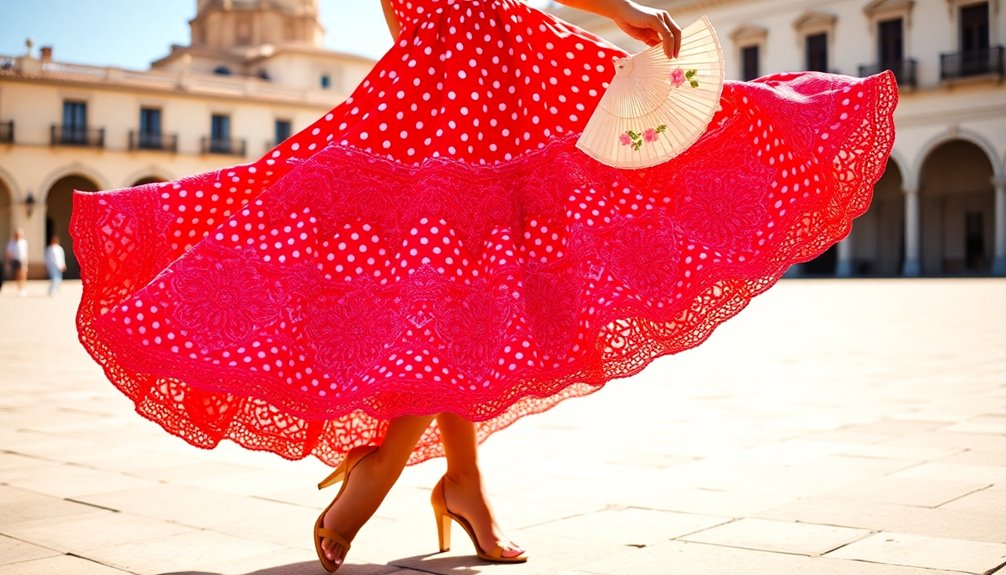
When styling your flamenco look, start with an essential ruffled blouse that adds volume and flair.
Pair it with flamenco-inspired accessories to elevate your outfit and incorporate layering with contrasting textures for a dynamic appearance.
These key elements will help you embody the spirit of flamenco fashion while ensuring you stand out.
Essential Ruffled Blouse
Embracing the essential ruffled blouse can elevate your wardrobe with its timeless elegance and versatility. This iconic piece, often found in traditional Spanish attire, features voluminous sleeves and intricate ruffle designs that infuse any outfit with femininity.
To create a balanced silhouette, style your ruffled blouse with high-waisted skirts or trousers. This combination works beautifully for both casual outings and formal events.
When selecting your ruffled blouse, opt for comfortable fabrics like cotton or silk, especially if you're in warmer climates. These materials not only enhance comfort but also add a luxurious touch.
For accessorizing, consider statement jewelry or a mantón (shawl) to amplify your look and celebrate Spanish cultural heritage.
The versatility of the ruffled blouse shines through, as it can be layered under jackets for cooler days or worn on its own for a breezy summer vibe.
Whether you're dressing for a festive occasion or a day out, the ruffled blouse remains a staple in both modern and traditional Spanish fashion.
Incorporating unique pieces into your outfit, much like how one would blend antiques in decor, can create captivating focal points that enhance your overall look.
With its captivating design and styling potential, you'll find countless ways to incorporate this essential piece into your wardrobe.
Flamenco-Inspired Accessory Pairings
Flamenco's vibrant spirit comes alive through its carefully curated accessories, each piece adding depth and character to your ensemble.
When styling your flamenco dress, consider the iconic Mantón de Manila. This large shawl, often made of silk or lace, enhances your movement and elegance, making it essential for both performers and enthusiasts.
Pair it with a decorative comb worn in your hair, known as a peineta. Not only does it secure your hairstyle, but it also adds a touch of traditional Spanish elegance with its intricate designs.
To further elevate your look, incorporate floral accents. Fresh or artificial flowers symbolize femininity and passion in flamenco culture, bringing vibrant colors that complement your dress beautifully.
Don't forget to choose the right footwear—flamenco shoes (zapatos de flamenco) are designed to create rhythm with your footwork while showcasing your style.
Lastly, bold jewelry choices, like statement earrings and necklaces inspired by traditional motifs, enhance your overall appearance, providing a striking contrast to the ruffles and colors of your flamenco dress.
With these accessory pairings, you'll embody the passionate essence of flamenco.
Layering With Contrasting Textures
Layering with contrasting textures can transform your flamenco look into a stunning statement. Pairing a soft, ruffled flamenco dress with a structured leather jacket adds depth that captures attention. This blend of feminine and edgy elements embodies the spirit of modern Spanish fashion, merging traditional elegance with contemporary flair.
For cooler days, consider incorporating lace tights under a flowing skirt. This unique juxtaposition not only enhances your overall aesthetic but also offers warmth. Mixing materials like silk and denim can further elevate your outfit, allowing you to showcase your individuality and creativity—key components of Spanish fashion identity.
Don't forget about accessories! A lace mantón can introduce a rich texture contrast that elevates even the simplest outfit, tying in elements of cultural heritage.
When you utilize vibrant colors and patterns in your layered pieces, you communicate your personal style while honoring the iconic flamenco dress's legacy.
Shopping Guide
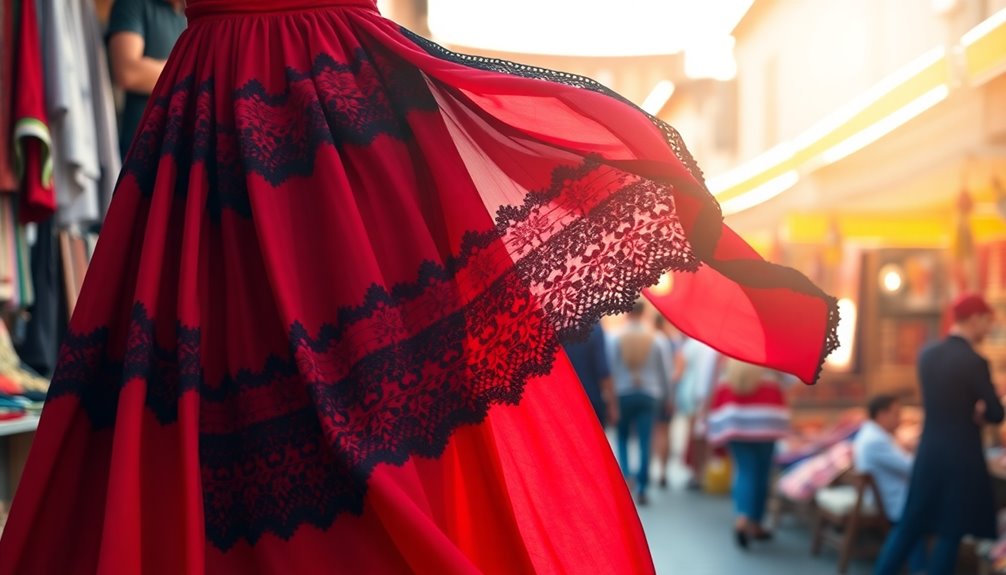
When you're ready to shop for traditional Spanish dresses, the traje de flamenca should be at the top of your list. This stunning garment is known for its vibrant colors, ruffles, and voluminous skirts that embody the spirit of flamenco culture.
Keep an eye out for dresses featuring lunares, or polka dot patterns, which add a playful touch to the overall look.
To complete your flamenco attire, consider essential accessories like a mantón, a beautifully embroidered shawl, and a peineta, a decorative comb that adds elegance. Lace tights are also a versatile choice, available in various patterns to suit different seasons.
If you're interested in a modern twist, explore contemporary brands that combine traditional Spanish elements with current fashion trends, emphasizing sustainability and ethical production methods.
Local boutiques in cities like Seville and Madrid offer unique flamenco attire, providing a chance to connect with artisans and discover one-of-a-kind pieces.
Handmade Flamenco-Inspired Accessories
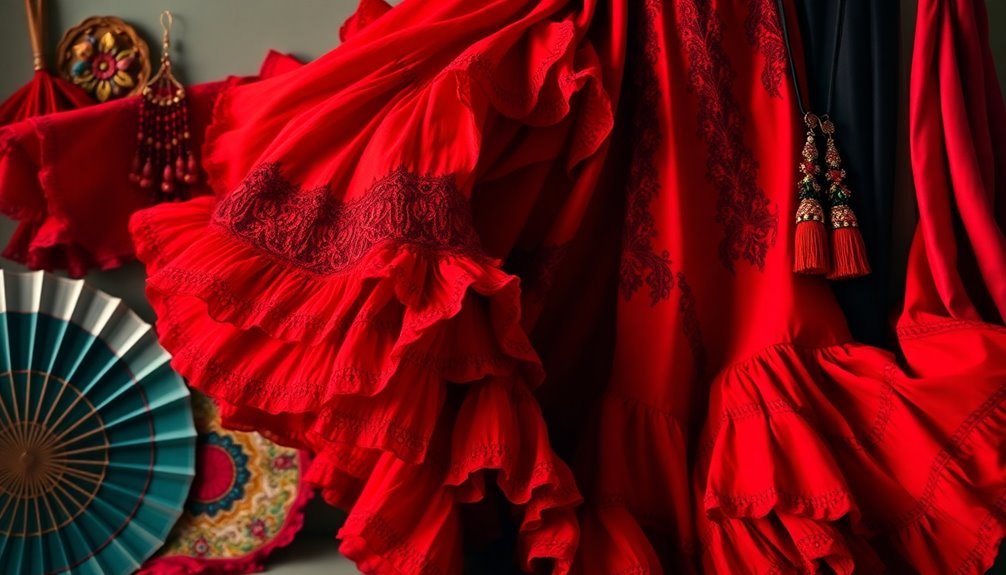
When you think about flamenco-inspired accessories, handcrafted ruffled hairpieces can instantly elevate your look.
You can also explore personalized embroidery options to make each piece uniquely yours, reflecting your individual flair.
Together, these details not only enhance your outfit but also celebrate the artistry behind flamenco fashion.
Handcrafted Ruffled Hairpieces
Embracing the vibrant spirit of flamenco, handcrafted ruffled hairpieces are a stunning addition to any outfit. These eye-catching accessories, often inspired by traditional flamenco attire, showcase vibrant colors and intricate designs that reflect the passion of Spanish culture. Made from high-quality materials like silk and lace, they enhance your elegance and durability for both performances and everyday wear.
Understanding the significance of these hairpieces, you'll find they're frequently adorned with embellishments like flowers and sequins, adding a festive flair that perfectly complements the dramatic style of flamenco dresses. Artisans create each piece using traditional techniques passed down through generations, ensuring that every hairpiece is unique and rich in cultural meaning.
Popular during festivals and flamenco performances, these ruffled hairpieces serve not just as fashion statements but also as a celebration of the rich heritage of Andalusian traditions. When you wear one, you're not just accessorizing; you're connecting with a vibrant history and expressing your appreciation for a culture that values artistry and passion. Additionally, like traditional food displays in Indonesian weddings, these accessories can serve as both decor and a representation of cultural identity.
Personalized Embroidery Options
Handcrafted accessories, like ruffled hairpieces, can be beautifully complemented by personalized embroidery options that add a unique touch to your flamenco-inspired wardrobe.
Imagine wearing a shawl or handbag adorned with intricate designs reflecting traditional Andalusian motifs, such as floral patterns and geometric shapes. These personalized embroidery choices let you choose your preferred colors and styles, transforming basic pieces into custom treasures that truly represent your identity.
Talented artisans dedicate hours to meticulously embroider each accessory, ensuring that every stitch showcases the skilled craftsmanship that goes into these creations.
As a flamenco dancer, you'll appreciate how these embroidered pieces not only enhance your attire but also connect you to the rich cultural heritage of Spain.
Opting for personalized embroidery supports local artisans and helps preserve traditional Spanish craftsmanship, making your accessories even more meaningful.
With every embroidered detail, you celebrate the artistry that defines flamenco culture while expressing your individuality.
Cultural Impact
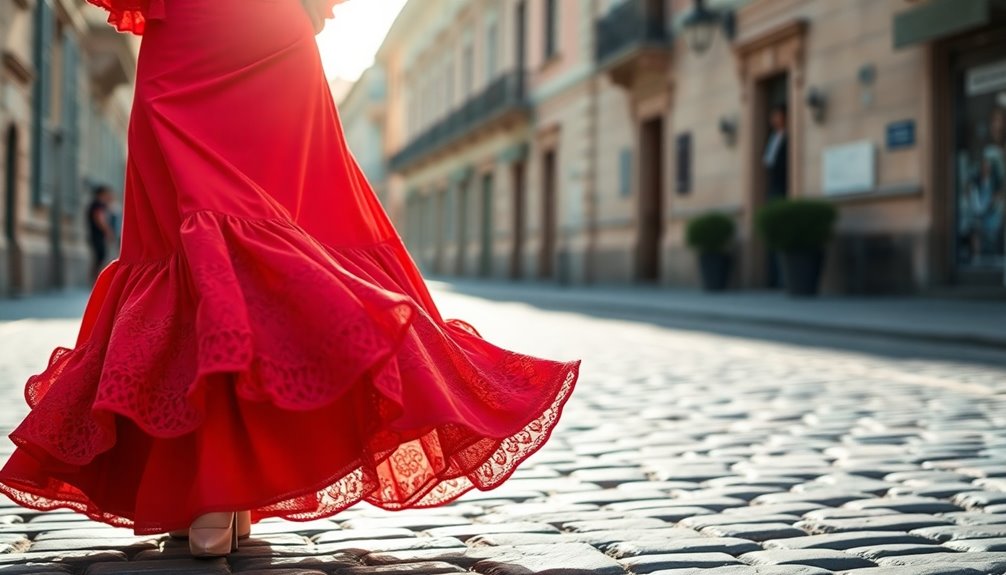
Flamenco's influence stretches beyond traditional performances, impacting contemporary music and fashion activism in Spain.
You can see how modern artists incorporate flamenco elements into their work, celebrating its vibrant heritage while pushing cultural boundaries.
This fusion not only honors the past but also sparks a conversation about identity and expression in today's society.
Flamenco in Contemporary Music
The vibrant rhythms and passionate melodies of Flamenco have woven their way into contemporary music, leaving a lasting cultural impact. You'll notice this influence as artists like Rosalía blend traditional Flamenco elements with urban and electronic sounds, creating a fresh and appealing sound that resonates globally. This fusion not only revitalizes interest in the genre but also showcases the emotional depth of Flamenco.
Flamenco dancers play a crucial role in this contemporary scene, often featured in music videos and live performances. Their dynamic movements and the striking attire from the world of flamenco fashion enhance the artistic expression, drawing viewers into a rich cultural narrative.
Celebrations like the Bienal de Flamenco in Seville provide platforms for musicians to reinterpret Flamenco, bridging the gap between past and present.
Moreover, collaborations between Flamenco artists and international musicians highlight the genre's adaptability, fostering enriching cross-cultural exchanges. As you explore contemporary music, you'll find that Flamenco's influence isn't just a trend; it's a powerful testament to the enduring beauty and relevance of this iconic art form.
Fashion Activism in Spain
In recent years, fashion activism in Spain has surged, with designers increasingly weaving social and political themes into their collections. This movement is deeply rooted in contemporary societal issues, showcasing the fashion industry's response to pressing challenges.
You'll notice that many brands prioritize eco-friendly materials and ethical production methods, using these practices as a form of activism that resonates with conscientious consumers.
Events like Madrid Fashion Week serve as platforms for bold statements, where collections challenge traditional norms and advocate for diversity and inclusion. Designers such as Matthieu Blazy at Chanel are pushing boundaries, addressing cultural heritage and representation through their work.
This fosters a deeper understanding of Spain's diverse identities, making fashion more than just clothing—it's a narrative.
Moreover, the integration of traditional Spanish elements into modern fashion reflects a commitment to preserving cultural heritage while simultaneously promoting awareness of social issues.
By highlighting these themes, Spanish designers showcase fashion as a powerful medium for activism, encouraging you to not only appreciate style but also to engage with the cultural and ethical implications behind it.
In this way, fashion activism is redefining what it means to wear your values.
Frequently Asked Questions
What Silhouette Was Introduced by Balenciaga in 1951?
In 1951, Balenciaga introduced the sack dress, a groundbreaking silhouette that transformed women's fashion.
You'll notice its loose, unstructured cut that falls straight from the shoulders, offering a relaxed and elegant fit. This design challenges traditional notions of femininity, emphasizing comfort and simplicity.
The sack dress not only influenced future designers but also paved the way for modern ready-to-wear fashion, making high fashion more accessible to everyone.
What Is Cristóbal Balenciaga's Most Famous Design?
Cristóbal Balenciaga's most famous design is the "sack dress," introduced in the 1950s.
You'll find this revolutionary piece characterized by its loose, straight lines, offering a relaxed fit that changed women's fashion forever. The sack dress eliminated the need for a defined waist, promoting comfort and freedom.
Balenciaga's innovative fabrics and draping techniques showcased his couture mastery, influencing countless designers and redefining the standards of contemporary women's fashion.
Who Invented the Sack Dress?
You might be surprised to learn that the sack dress was invented by Spanish designer Cristóbal Balenciaga in the 1950s.
This revolutionary design broke away from traditional fitted styles, offering a loose, free-flowing silhouette that prioritized comfort and movement.
What Inspired Cristóbal Balenciaga?
Cristóbal Balenciaga was inspired by his Spanish heritage, especially the traditional garments of the Basque region.
You'd notice how he drew from the architectural shapes found in nature and art, creating designs that emphasized form and volume.
His innovative spirit pushed him to experiment with new materials and techniques, aiming for comfort and elegance.
The cultural richness of Spain, with its folklore and costumes, profoundly influenced his unique aesthetic and design philosophy.
